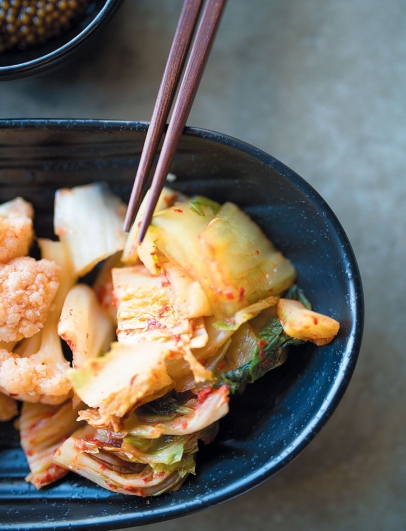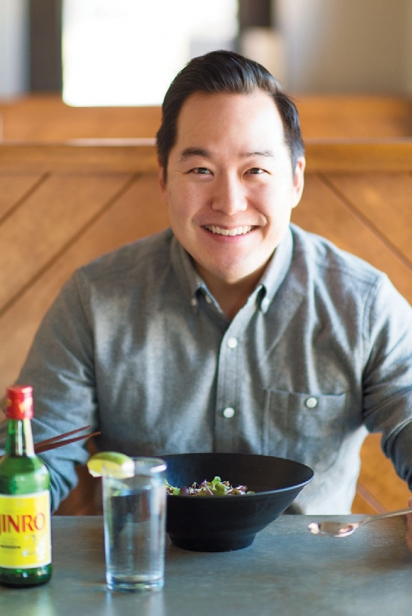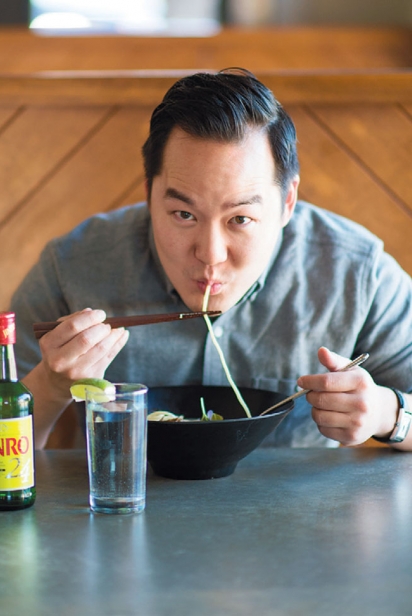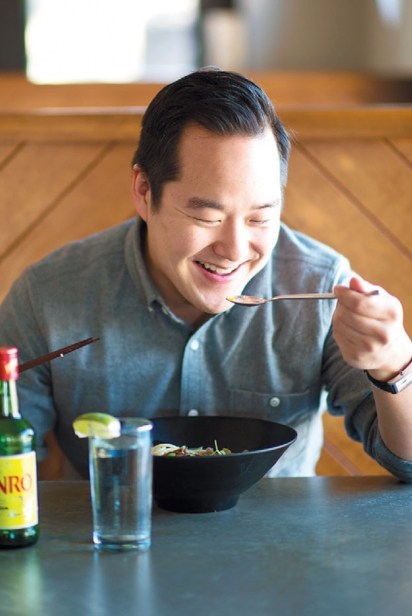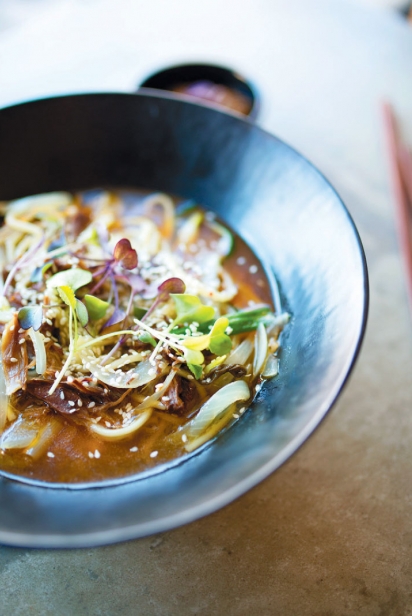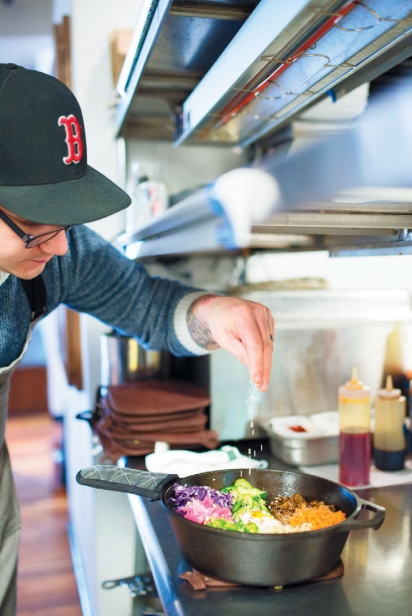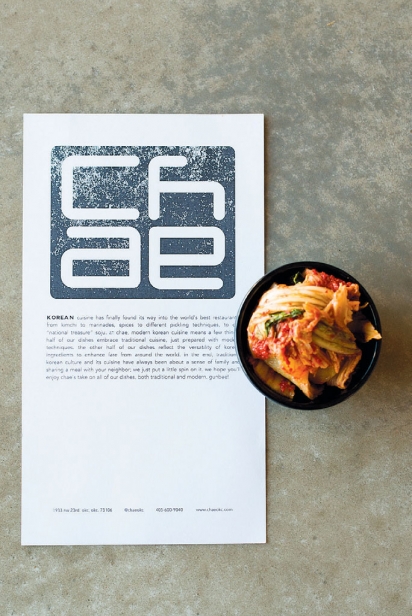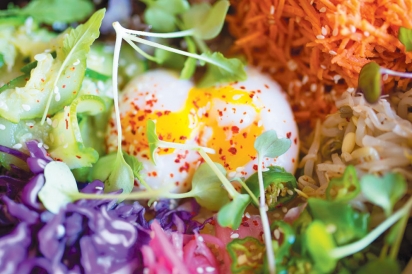Chae: Modern Korean
When my husband and I travel we unapologetically base most of our plans around the food we want to encounter—we are gastronomic tourists of sorts. In 2009, my sister had a wedding reception in South Korea, and I traveled with her and her husband for a little over a week, eating my way though the city of Seoul. Most of the time my brother-in-law, who is fluent in the language, would order for the whole lot of us, and dinner would be a constant exploration of new foods, unique tastes, and me and my noticeable (read: clumsy) chopstick skills trying very hard not to fling food across the table. While every meal was different and a surprise, my constant and familiar companion throughout the journey was kimchi.
With fermentation being the theme for this issue, my mind immediately went to kimchi and one of my new favorite restaurants in Oklahoma City, CHAE. CHAE is a modern Korean cuisine restaurant with its name born after the friendly and food passionate owner, Daniel Chae. Every time we’ve been in, Daniel has been there to greet us with a smile and enthusiastically explains the dishes to us. My favorite description being that a dish is “like a warm hug”—I would go further to say that the whole CHAE experience is that way!
Name: Daniel Chae
Website: chaeokc.com
Where can we drop in and try out CHAE?
On the edge of the Uptown 23rd and Asian Districts, right off of OCU’s campus. 1933 NW 23rd, OKC
When did you start your business?
We’re brand new! Opened November 2015.
Why Modern Korean?
Traditional Korean dishes taste so good and can satisfy any palate; at the same time, Korean ingredients and preparation styles can now be found in some of the world’s best restaurants. At CHAE, we wanted to showcase both. Half of our menu is simple and traditional, while the other half shows the versatility of Korean ingredients in other cuisines.
Tell us a little background on your business, where your inspiration came from, and what made you decide to take the plunge and open CHAE:
More than anything, CHAE was born out of a desire to take care of people; after all, Korean food has always been about bringing comfort after a long, hard day. It’s why Korean cuisine, for the most part, is humble and has no frills.
But taking the plunge to elevate Korean food wasn’t easy; in fact, it was amazingly nerve-wracking considering all the obstacles, staffing being the biggest question. It wasn’t until I met Taylor Desjarlais, who’s now chef de cuisine, and Sam Salinas, our sous chef, that I felt like we could respectfully execute both a traditional and modern menu.
What is your favorite item on the menu?
The dish that started it all—our Iron Bibimbap. A variety of carefully seasoned vegetables and marinated beef, topped with a few perfectly prepared eggs, all sitting atop a bed of lightly toasted rice. It’s the stuff of legends.
How did you develop your menu?
Kevin Lee, chef de cuisine at Vast, is a long-time friend of mine. As Korean-Americans, we both longed for good Korean food, and so from there our sense of excitement grew at the thought of getting to share Korean food with Oklahomans. And believe it or not, the menu all started with and was inspired by a shot of soju.
Chef Kevin is a Coach-House alumni and has all the makings of a great chef. As the apprentice of many of the Western Concepts restaurants, I credit our initial menu to him. I also credit him for bringing another Coach House grad to our team, chef Taylor Desjarlais, who’s now CHAE’s chef de cuisine. Amazingly, Taylor’s French-style cooking meshed well with Kevin’s menu, and together they elevated the dishes even more.
Speaking of, soju is a distilled rice wine. It goes down smooth and clean and has a tasting note that’s similar to light vodka. If you’re thinking that sounds like rubbing alcohol, well, it is. And it pairs amazingly with food. In fact, at CHAE, there’s only one way to eat food: do a shot of soju, and chase it immediately with a bite of a galbi taco or bibimbap.
What drives your food concept? Does it make you feel good? Can you tell us a little about Korean food?
For the better part of the last century, Korea was either occupied by another country or fighting a war. So as a post-colonized AND post-war country, making everything pretty much about survival, including the ability to store food for a long time. It’s a story that repeats itself across all types of cuisine around the world.
Another important part of Korean cuisine is soju. I joked about it earlier, but the importance of soju can’t be understated.
Fermentation plays a significant role in traditional Korean cuisine. How do you honor that tradition while also setting yourself apart?
Actually, this is one part of our menu that we keep old school. Almost anything can be pickled and/or fermented, and at CHAE we do both. But at a typical/traditional dining table, the dishes are served tapas style in what many people know as banchan. The acids are separated from the base dishes so people can pick and choose how much to eat of each component. This process can often times be overwhelming to the novice Korean food diner. So at CHAE, we put together and combine the components to actually create an entree with those different dishes.
What is the most rewarding part of your business?
Without a doubt, getting to work with such an amazing crew. I have so much appreciation and respect for Taylor and Sam. These guys cook with so much integrity. Beyond the back of the kitchen, our restaurant operations are managed by Hunter Desjarlais (yes, they’re married!) and Caitlin Barnett. These four have done a superb job executing an entirely brand new concept.
Tell us a little about your food & business theory.
People know when you’ve worked hard to make a dish. You can’t take shortcuts that affect integrity. It’s why two amazing chefs, Taylor and Sam, are at a humble start-up. We all believe in being thoughtful with each dish, and I think our guests know that. Even our most humble, seemingly simple dish like the duck jook—a duck confit, rice porridge—is crafted together with the utmost care and integrity.
What aspects of Oklahoma City do you think are best for having a restaurant?
I think everyone is hungry for more of everything—more development, more art, more things to do, and more (and better) places to eat. There’s suddenly so much competition that you have to be thoughtful and be purposeful every step of the way.
In what ways do you wish to see Oklahoma City grow, and which aspects do you hope never change?
To me they’re actually one in the same. There are so many ample opportunities to collaborate and create new places, and in good ole-fashioned OKC, it’s easy to reach out to some of the best mentors the city has to offer. The desire to keep growing has always been one of OKC’s best traits. It’s easily the thing I hope never changes and what I think will usher in growth.
If we were a first time CHAE diner, what would you suggest that we order to have the full experience?
Prepare yourself: start with a bottle of soju for the table and a soju cocktail for yourself. You’ll definitely want to get the pork buns, galbi tacos, and Brussels sprout salad. These are modern yet safe dishes that are just ridiculously good. From there, go old school: the Iron Bibimbap, the duckjook porridge, and if you’re wanting noodles and broth, the oxtail soup. And if there’s room, folks have returned dreaming about our hoedduck dessert: flatbread filled with brown sugar, topped with cinnamon, vanilla ice cream and candied nuts.
Thank you so much Daniel for giving us some insight on your restaurant & heritage!


